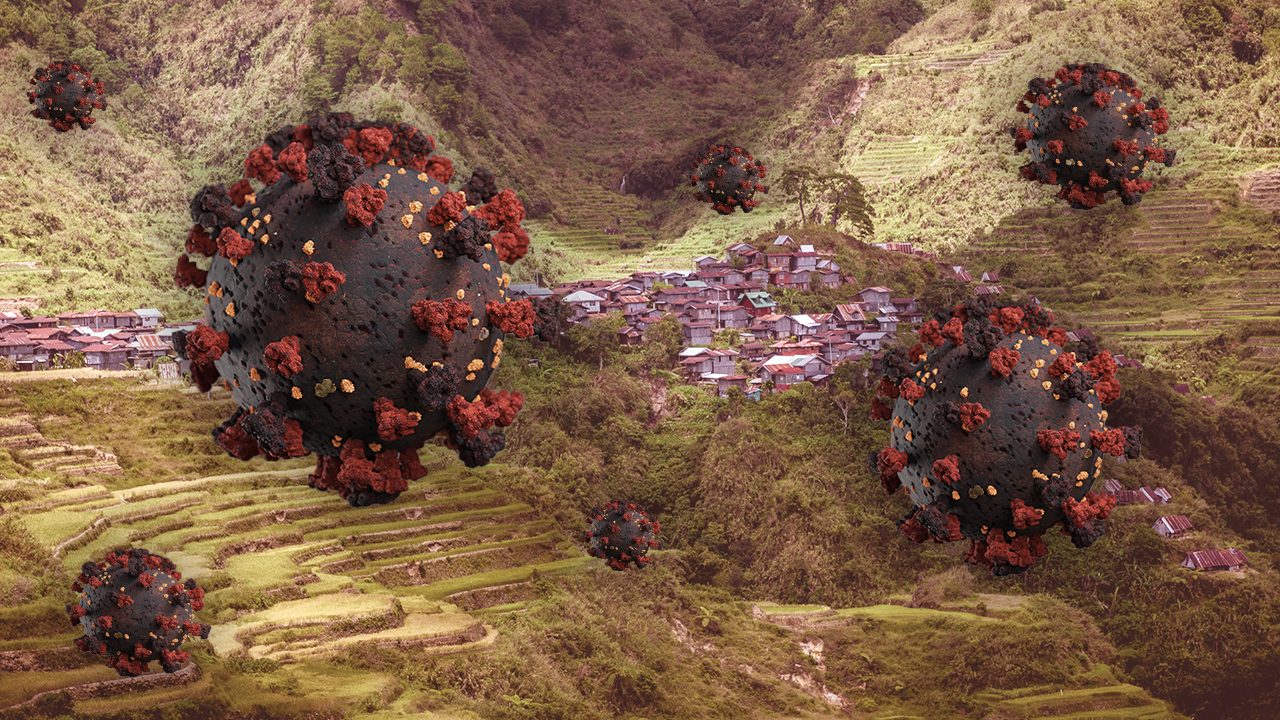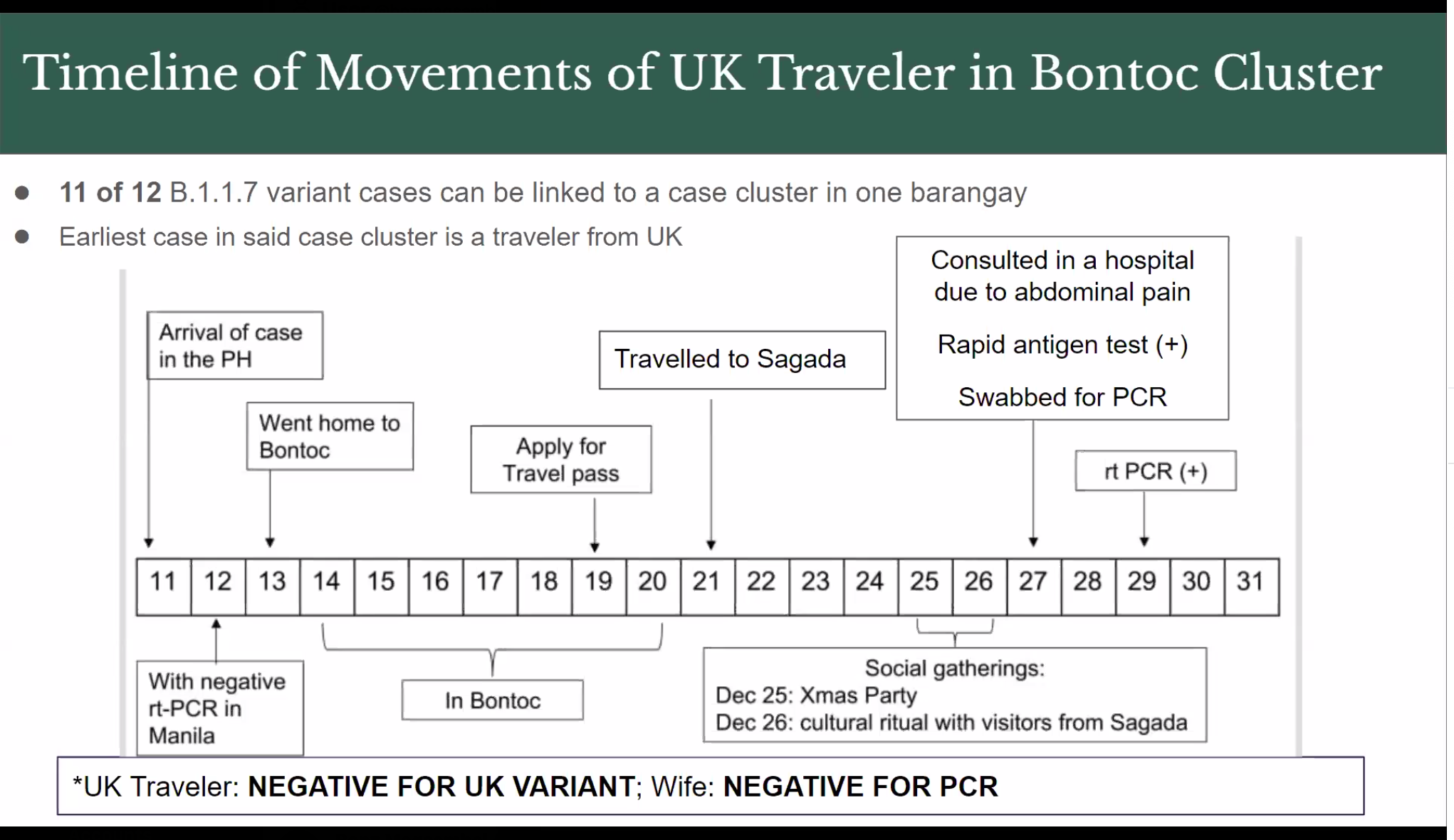SUMMARY
This is AI generated summarization, which may have errors. For context, always refer to the full article.

On Monday night, January 25, the Department of Health (DOH) confirmed a local transmission of the more infectious United Kingdom (UK) COVID-19 variant in Bontoc, Mountain Province after it detected 12 cases there.
However, overriding questions remain unanswered. How did the UK variant spread in Bontoc? Who brought the virus there?
The DOH said on Monday that the clustering of COVID-19 cases in Barangay Samoki in Bontoc was reported to have begun with a Filipino returning from the UK, who arrived in town with his wife on December 14 through a private vehicle after testing negative for COVID-19.
The DOH said that it identified 46 COVID-19 positive close contacts linked to the traveler from the UK. Twelve of them are positive for the UK variant –the reported cases in Bontoc – while 6 are negative for this variant.
The remaining 28 specimens will be sent to the Philippine Genome Center (PGC) for genome sequencing.
Genomic sequencing is the process of analyzing the virus sample taken from a diagnosed patient and comparing it with other cases to see whether those who tested positive for COVID-19 have the new variant.
The tracing became tricky when the DOH said that the traveler from the UK was positive for COVID-19, but that his samples didn’t have the more infectious variant. Meanwhile, his wife tested negative for COVID-19.

The DOH in earlier briefings identified him as the index case – or the common contact of the other coronavirus-positive cases – in Bontoc, but a health official said on Tuesday, January 26, that they could not conclude yet if he is the “source of infection.”
“As of now, we’re not concluding that this [traveler from the UK] is the source of infection. Dahil una, nag-negative nga siya [sa UK variant] at ‘yung wife niya (Because he tested negative for the UK variant and his wife tested negative as well). Nakikita nga natin na naka-link sa kaniya ang mga cases (We’re seeing that the cases there are linked to them). It needs further investigation to definitely say whether he is or he is not the source of infection,” said Dr Alethea de Guzman of the DOH’s Epidemiology Bureau.
The DOH said on Monday that local authorities were also “identifying and interviewing other” returning overseas Filipinos who recently arrived in Bontoc to determine their health, laboratory, and quarantine status.
Meanwhile, De Guzman said that she could not tell yet if the Bontoc cases got the UK variant from tourists or locals there.
On October 22, 2020, Baguio City, which is part of the Cordillera Administrative Region (CAR), reopened its doors to tourists from Luzon but with a cap of 200 tourists a day. In December, Mayor Benjamin Magalong said the City of Pines has opened to travelers from Visayas and Mindanao, raising the cap to 1,000 tourists per day.
Mountain Province is also part of CAR. Even before the detection of UK variant cases in Bontoc, CAR has been under monitoring due to the rising cases and increasing hospital occupancy rate.
The UK variant known as B117 was first detected in the United Kingdom in September 2020. In November, around a quarter of the reported COVID-19 cases in the country were found to be of the new variant of SARS-CoV-2, the virus that causes COVID-19. (READ: New COVID-19 variant: What we know so far)
What could have gone wrong?
In a press briefing on Saturday, January 23, Dr Edsel Salvana from the health advisory technical working group said samples from one of the 16 patients who were recently found to be positive for the UK variant was collected last December 10, which means that the UK variant was already in the country last year.
Nearly a year after the Philippines detected its first case of COVID-19, the government will implement the 5th-day testing of inbound travelers starting February 1. Arriving passengers, regardless of their origin, shall also be required to undergo facility-based quarantine, although they are no longer required to undergo testing upon arrival.
But prior to the detection of the presence of the UK variant in the country, inbound travelers could go home after getting negative PCR test results even without finishing the 14-day quarantine in designated isolation facilities.
The World Health Organization defines incubation period as the time between exposure to the virus and symptom onset, which is 5 to 6 days on average, but can be as long as 14 days.
The incubation period of the virus, however, has not changed since the pandemic began. The DOH only recommended the strict mandatory 14-day quarantine protocol regardless of results in late December 2020.
The country confirmed its first known case of the UK variant on January 13 in a Filipino male resident from Quezon City who traveled to Dubai on December 27 and returned to Manila on January 7. The DOH said he already tested negative for COVID-19.
The country has so far detected 17 cases of the UK variant. – Rappler.com
Add a comment
How does this make you feel?
There are no comments yet. Add your comment to start the conversation.